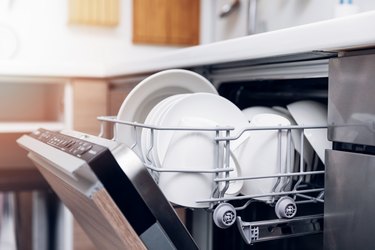When the dishwasher shuts off before finishing a cycle, and you see a pool of standing water at the bottom, the first thing to do is to press the power button to resume the cycle. The machine may have shut off by mistake, and restarting it may clear the water. If the machine runs through its cycle or shuts off again, and you still see standing water in the dishwasher, you've probably got a clog to clear.

Video of the Day
Sometimes It's Easy to Unclog a Dishwasher
The water that washes your dishes passes through a filter basket in the bottom of the dishwasher and into the drain. From there, it gets pumped through a hose to the sink, where it attaches to the sink tailpipe by means of a T-connector. If you have a garbage disposal, the dishwasher connects to that.
Video of the Day
A clogged filter basket is the first suspect. To inspect it properly, you may have to transfer water to a bucket using a sponge or a cup. If it's full of food bits, go ahead and remove them. If that fixes the problem, remember to rinse your dishes more thoroughly before putting them in the dishwasher.
It's also possible there's a clog inside the garbage disposal or the drain hose. Run the garbage disposal to make sure it isn't blocked, and then remove the drain hose and inspect the hose and the inlet port for debris. You should do this even if you don't have a garbage disposal. Either one of these procedures could solve the problem.
Check That Hose a Little More Closely
The corrugated plastic hose that connects the dishwasher to the drain can easily catch chunks of debris. To thoroughly clean it, you should disconnect it from the dishwasher. It's connected underneath, so you'll probably have to pull the machine out of its alcove to access the connection. Keep a bucket handy to catch any water that spills out of the dishwasher when you remove the hose.
Disconnect the other end of the hose from the sink and take the hose outside. Clean it by spraying water through it with a garden hose.
If you don't have a garbage disposal, the hose makes a loop inside the sink cabinet and connects to a metal dome-like device on the sink deck called an air gap. Clean this out with a small bottle brush to make sure it isn't blocked.
Unclog the Dishwasher
If you can verify that the drain hose and garbage disposal are clear, the clog has to be in the dishwasher itself. Since you already cleaned the filter basket, you'll have to dig deeper into the drain to find it. If there is still standing water, keep the bucket handy because it will start flowing if you manage to clear the clog.
Remove the filter basket and pick out any food debris you find around the drain opening. Poke a length of wire into the opening to loosen food clinging to the pump impellers. A zip-it drain cleaning tool is an ideal implement for this. If water starts flowing into the bucket, you're on the right track.
Sometimes It Takes a Pro
If you can't get the dishwasher to drain properly, call an appliance pro. There may be a problem with the pump impellers or other components of the dishwasher.
Never put a drain cleaner like Drano in the dishwasher. Corrosive drain cleaners damage the dishwasher, the drain hose and the garbage disposal, and they create a hazard for anyone who works on the drain.